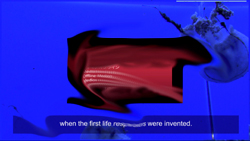Videos by Oliver Laric, Liz Magic Laser, llya Lipkin & Joen Vedel, Takeshi Murata & Billy Grant, Rachel Rose, Georgia Sagri, Shanzhai Biennial, Pilvi Takala, and Stewart Uoo

Wednesday, August 14, 2013
6:30 pm
Electronic Arts Intermix (EAI)
535 West 22nd Street, 5th floor
New York, NY 10011
www.eai.org
Admission Free
Please join EAI for Uncanny Valleys, a special summer screening of new and recent video works by young artists who are exploring the formal, conceptual, and critical possibilities that emerge from interaction with unfaithful simulations, imperfect replication, and the slightly wrong. On a graph plotting emotional response to human likeness, the "uncanny valley" is a region of profound visceral unease elicited by simulated human features that look, move, or behave in ways that are almost, but not quite, natural. This response is why robotic characters like C3PO and R2D2 are perceived as cute, but a robot with synthetic skin, fake hair, and moving eyes is deeply disquieting. Uncanny Valleys measures both the width and depth of the uncanny valley, featuring videos that deploy inauthentic likenesses of human beings or deliberately skewed or bootleg versions of fictional characters, as well as inexact or differential copies of images, objects, and places. Casting a wide net with this metaphor, the videos in the screening program ask questions about how flawed proxies can be deployed for formal experimentation or social, economic, and political critique.
Georgia Sagri's new video Tromi (2013), created using the camera on her laptop, confronts us with a face augmented and altered through cosmetics, running through random affected expressions the way a screensaver cycles through images. In Snow White (2009), Finnish artist Pilvi Takala documents the reaction of staff and visitors at Disneyland Paris when she arrives at the gates of the theme park dressed in unapproved attire. Versions (2012), by Oliver Laric, is an essay on variation, copying, and mutation that questions the possibility of originality in a world flooded with divergent and convergent images, objects, artworks, and phenomena. Art collective/brand Shanzhai Biennial's newest video—inspired by Chinese knock-off culture—is a polished, high-definition series of nested, interlocking, and utterly inaccurate bootlegs. Liz Magic Laser's video documents a performance in London based on the body language of world leaders delivering public speeches. Stewart Uoo's Confessions (9 Women) (2012) imagines the mind of avatars, marrying a voiceover reenactment of reader-submitted confessions from Cosmopolitan magazine with violent first-person shooter video game footage. Rachel Rose looks at artificial life in Sitting Feeding Sleeping (2013), a speculative video essay that takes in cryogenics, regenerative medicine, machine evolution, and sea life. In Berlin-based artists Ilya Lipkin & Joen Vedel's newest video, a commercial editor's anecdotes about building commercials are layered with images of images being manipulated on glossy, reflective screens. Finally, in Takeshi Murata's collaboration with Billy Grant, Night Moves (2012), hacked 3D-scanning software draws an entire real environment into digital space, creating lush, fractured augmented reality.
Friends of EAI Membership 2013
Become a 2013 Friends of EAI Member at one of four different levels and enjoy a range of wonderful benefits, including complimentary tickets to EAI's on-site public programs and special access to the artists and works in the EAI collection. Membership helps to support our programs and services, including our online resources, educational outreach, and vital preservation activities. By becoming a Friend of EAI, you support the future of media art and artists. Memberships begin at $40 ($25 for students).
For more information, and to become a member, please visit:
https://www.eai.org/eai/members.htm
About EAI
Founded in 1971, Electronic Arts Intermix (EAI) is one of the world's leading nonprofit resources for video art. A pioneering advocate for media art and artists, EAI fosters the creation, exhibition, distribution, and preservation of video art and digital art. EAI's core program is the distribution and preservation of a major collection of over 3,500 new and historical media works by artists. EAI's activities include viewing access, educational services, extensive online resources, and public programs such as artists' talks, exhibitions and panels. The Online Catalogue is a comprehensive resource on the artists and works in the EAI collection, and also features extensive materials on exhibiting, collecting and preserving media art:
www.eai.org
__________________________________
Electronic Arts Intermix
535 West 22nd Street, 5th Floor
New York, NY 10011
t (212) 337-0680
f (212) 337-0679
info@eai.org
EAI on Facebook
EAI on Twitter
___________________________________
This program is supported, in part, by public funds from the New York City Department of Cultural Affairs.
